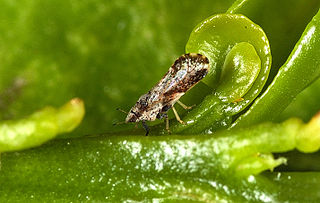
Septoria are ascomycete pycnidia-producing fungi that cause numerous leaf spot diseases on field crops, forages and many vegetables including tomatoes which are known to contract Septoria musiva from nearby cottonwood trees, and is responsible for yield losses. The genus is widespread, and estimated to contain 1072 species. Pycnidia produce needle-like pycnidiospores.

Psyllidae, the jumping plant lice or psyllids, are a family of small plant-feeding insects that tend to be very host-specific, i.e. each plant-louse species only feeds on one plant species (monophagous) or feeds on a few closely related plants (oligophagous). Together with aphids, phylloxerans, scale insects and whiteflies, they form the group called Sternorrhyncha, which is considered to be the most "primitive" group within the true bugs (Hemiptera). They have traditionally been considered a single family, Psyllidae, but recent classifications divide the group into a total of seven families; the present restricted definition still includes more than 70 genera in the Psyllidae. Psyllid fossils have been found from the Early Permian before the flowering plants evolved. The explosive diversification of the flowering plants in the Cretaceous was paralleled by a massive diversification of associated insects, and many of the morphological and metabolic characters that the flowering plants exhibit may have evolved as defenses against herbivorous insects.

Citrus greening disease or yellow dragon disease is a disease of citrus caused by a vector-transmitted pathogen. The causative agents are motile bacteria, Liberibacter spp. The disease is transmitted by the Asian citrus psyllid, Diaphorina citri, and the African citrus psyllid, Trioza erytreae, also known as the two-spotted citrus psyllid. It has no known cure. It has also been shown to be graft-transmissible.

Citrus canker is a disease affecting Citrus species caused by the bacterium Xanthomonas. Infection causes lesions on the leaves, stems, and fruit of citrus trees, including lime, oranges, and grapefruit. While not harmful to humans, canker significantly affects the vitality of citrus trees, causing leaves and fruit to drop prematurely; a fruit infected with canker is safe to eat, but too unsightly to be sold. Citrus canker is mainly a leaf-spotting and rind-blemishing disease, but when conditions are highly favorable, it can cause defoliation, shoot dieback, and fruit drop.

Alternaria is a genus of Deuteromycetes fungi. All species are known as major plant pathogens. They are also common allergens in humans, growing indoors and causing hay fever or hypersensitivity reactions that sometimes lead to asthma. They are present in the human mycobiome and readily cause opportunistic infections in immunocompromised people such as AIDS patients.

Zymoseptoria tritici, synonyms Septoria tritici, Mycosphaerella graminicola, is a species of filamentous fungus, an ascomycete in the family Mycosphaerellaceae. It is a wheat plant pathogen causing septoria leaf blotch that is difficult to control due to resistance to multiple fungicides. The pathogen today causes one of the most important diseases of wheat.
Mycosphaerella citri is a fungal plant pathogen infecting citruses.
Septoria ampelina is a fungal plant pathogen that affects grapes causing septoria leaf spot.
Septoria cucurbitacearum is a fungal plant pathogen infecting cucurbits. Symptoms of Septoria leaf spot are similar on all the cucurbits infected.
Septoria fragariae is a fungal plant pathogen affecting strawberries.
Septoria helianthi, also known as Septoria leaf spot, is a fungal plant pathogen infecting sunflowers.
Septoria pistaciae is a fungal plant pathogen infecting pistachios. It causes a disease known as septoria leaf spot in the leaves of pistachio, along with the related species septoria pistaciarum and septoria pistacina.
Septoria selenophomoides is a fungal plant pathogen infecting orchids. It causes leaf spots, starting with small yellowish lesions on the plant's leaves and darkening to brown or black. If the infection develops further, the leaves and fruit fall from the orchid and spread the infection.
Alternaria citri is a fungal plant pathogen that causes black rot in citrus plants.
Septoria lycopersici is a fungal pathogen that is most commonly found infecting tomatoes. It causes one of the most destructive diseases of tomatoes and attacks tomatoes during any stage of development.
Mycosphaerella eumusae is a fungal disease of banana, causing Eumusae leaf spot. Its symptoms are similar to black leaf streak. M. eumusae is the predominant Mycospharella of banana in mainland Malaysia and in Thailand, and is present in Mauritius and Nigeria. Septoria eumusae is an anamorph of Mycosphaerella eumusae.

Diaphorina citri, the Asian citrus psyllid, is a sap-sucking, hemipteran bug in the family Psyllidae. It is one of two confirmed vectors of citrus greening disease. It has a wide distribution in southern Asia and has spread to other citrus growing regions.

Clara Henriette Hasse was an American botanist whose research focused on plant pathology. She is known for identifying the cause of citrus canker, which was threatening crops in the Deep South.







